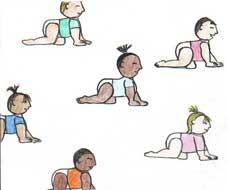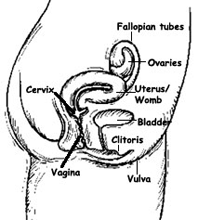14.- REPRODUCTION
The sperm swims up the vagina [vaj-eye-na], through the cervix [sir-vix], into the uterus [you-ter-us] and then into the fallopian [fal-o-pe-an] tubes of the female. These sperm are looking for an ovum (or egg) to fertilise.

This fertilised ovum immediately divides into two cells, these cells then divide again and again over the next couple of days as the cluster of cells makes its way to the uterus (womb). Here it is planted in the lining of the uterus and continues dividing its cells to make billions of new cells.
The amazing thing is that each one of these cells contains the same set of chromosomes or ’plans’ that were created at fertilisation!
Over 9 months, these cells will grow into a new person - a baby.
| Doctors have different names for this developing baby. | |
| 1 day - ’zygote’ | |
| 1 month - ’embryo’ | |
| 3rd month to birth - ’foetus’ [feet-us] (also sometimes spelt ’fetus’) | |
When your dad’s sperm and mum’s egg [ovum] got together, they each brought a set of ’plans’ for what the new baby would be like.
 | When the ovum was fertilised and became your first cells, these ’plans’ or genes helped to decide lots of things about you, eg. boy or girl, colour of skin, eyes, hair, etc. |
| Genes are made of DNA (’de-ox-y-ri-bo-nu-cle-ic acid’, if you want the full name). | |
| If you could see your genes they would look like beads on a necklace of DNA. These strands are called ’chromosomes’. |
Usually each cell in a human body has 46 chromosomes.
That first single cell has 23 chromosomes from mum and 23 from dad, which is why you might look like mum or dad [or grandparents] and have similar traits, eg. you and dad may have pointy ears, or you and mum can both wiggle your noses! The chromosomes in a male are slightly different to those in a female. This is a picture of chromosomes in a male. |
 |
Remember, any one sperm can only fertilise one ovum, so if 2 ova (eggs) leave the ovaries at the same time and are both fertilised then ’non-identical’ twins are born. They may look alike or they may not, just like any brothers or sisters.
If an ovum splits after it has been fertilised, then you get identical twins because they have the same set of genes.
It is called a multiple birth if two or more babies are born at the same birth. Do you know what we call a set of three babies who are born at the same time?
What sex you are
What sex a baby will be is decided when the egg and sperm unite.
Each egg and each sperm have one sex chromosome.
There are two kinds of sex chromosomes - X and Y. Can you see why they are called x and y chromosomes?
Eggs carry only an X and sperm carry either an X or a Y
X+X means the cell will develop into a baby girl.
X+Y means that it will develop into a boy.
| Once you are born, you will grow up into a unique human being - there’s no-one else like you in the world. Even identical twins are not exact copies of each other - they each have their own personalities. |  |
| You may look a bit like someone in your family, but there is only one of you! | |
| You are a completely unique and wonderful person. | |
Inside the uterus (womb)
The place where the embryo plants itself is inside the uterus. The baby starts to grow, and other tissue grows into a placenta [say plas-ent-a].
 During pregnancy (the time when the baby is growing in mum’s uterus), the placenta provides oxygen from the air that mum breathes, and nutrients [say new-tree-ents] from the food she eats.
During pregnancy (the time when the baby is growing in mum’s uterus), the placenta provides oxygen from the air that mum breathes, and nutrients [say new-tree-ents] from the food she eats.
Some of the nutrients from what mum eats or drinks, and oxygen from the air she breathes, goes through the umbilical cord to the foetus. Any waste from the growing baby goes back through the cord into the mother’s bloodstream and passes out of her body.
The umbilical cord is a soft ’bendy’ tube from the placenta to the navel [or tummy button] of the foetus.
There is a sac (like a bag of thin skin) filled with fluid protecting the skin of the developing baby. The baby can move around safely inside the mother for 9 months until he or she is ready to be born into our world.
 When sperm are ejaculated [say e-jak-u-lay-ted] from the penis during sexual intercourse, they swim up the vagina [vaj-eye-na], through the cervix [sir-vix], into the uterus [you-ter-us] and then into the fallopian [fal-o-pe-an] tubes of the female. These sperm are looking for an ovum (or egg) to fertilise.
When sperm are ejaculated [say e-jak-u-lay-ted] from the penis during sexual intercourse, they swim up the vagina [vaj-eye-na], through the cervix [sir-vix], into the uterus [you-ter-us] and then into the fallopian [fal-o-pe-an] tubes of the female. These sperm are looking for an ovum (or egg) to fertilise. 
0 comentarios